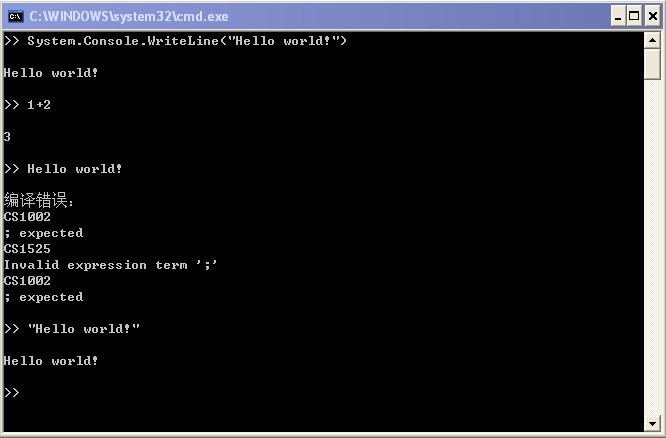1、简介
能够动态执行 C# 代码是一件很酷的功能,比如,我们可以在控制台中输入一行 C# 代码,然后程序自动编译并执行这一行代码,将结果显示给我们。这差不多就是一个最简单的 C# 代码解释器了。
动态执行 C# 代码又是一件很有用的功能,比如,我们可以将某些代码写在某个文件之中,由程序集在执行时进行加载,改变这些代码不用中止程序,当程序再次加载这些代码时,就自动执行的是新代码了。
下面,我将在写一个简单C# 代码解释器,然后将在 C# 代码解释器之中加入动态代码与解释器环境间的动态交互机制,来演示一个很好很强大的应用。
2、简单的 C# 代码解释器
关于如何动态执行 C# 代码在 Jailu.Net 的《如何用C#动态编译、执行代码》一文中讲述的很清晰。采用该文所述方式写一个 C# 代码解释器:

using System;

using System.Collections.Generic;

using System.Reflection;

using System.Globalization;

using Microsoft.CSharp;

using System.CodeDom;

using System.CodeDom.Compiler;

using System.Text;

using System.IO;

using System.Xml;


namespace Test



{

class Program



{

static void Main(string[] args)



{

Console.Write(">> ");

String cmd;

Context cxt = new Context();

while ((cmd = Console.ReadLine().Trim()) != "exit")



{

if (!String.IsNullOrEmpty(cmd))



{

Console.WriteLine();

cxt.Invoke(cmd);

}

Console.Write("\n>> ");

}

}

}


public class Context



{


public CSharpCodeProvider CodeProvider

{ get; set; }


public IDictionary<String, Assembly> Assemblys

{ get; set; }


public Context()



{


CodeProvider = new CSharpCodeProvider(new Dictionary<string, string>()

{

{ "CompilerVersion", "v3.5" } });

Assemblys = new Dictionary<String, Assembly>();

Assembly[] al = AppDomain.CurrentDomain.GetAssemblies();

foreach (Assembly a in al)



{

AddAssembly(a);

}

AppDomain.CurrentDomain.AssemblyLoad += new AssemblyLoadEventHandler(CurrentDomain_AssemblyLoad);

}


private void AddAssembly(Assembly a)



{

if (a != null)



{

Assemblys.Add(a.FullName, a);

}

}


void CurrentDomain_AssemblyLoad(object sender, AssemblyLoadEventArgs args)



{

Assembly a = args.LoadedAssembly;

if (!Assemblys.ContainsKey(a.FullName))



{

AddAssembly(a);

}

}


public CompilerParameters CreateCompilerParameters()



{

CompilerParameters cp = new CompilerParameters();

cp.GenerateExecutable = false;

cp.GenerateInMemory = true;

if (Assemblys != null)



{

foreach (Assembly a in Assemblys.Values)



{

cp.ReferencedAssemblies.Add(a.Location);

}

}

return cp;

}


public void Invoke(String cmd)



{

String inputCmdString = cmd.Trim();

if (String.IsNullOrEmpty(inputCmdString)) return;


String fullCmd = BuildFullCmd(inputCmdString);


CompilerResults cr = CodeProvider.CompileAssemblyFromSource(CreateCompilerParameters(), fullCmd);


if (cr.Errors.HasErrors)



{

Boolean recompileSwitch = true;


foreach (CompilerError err in cr.Errors)



{

//CS0201 : Only assignment, call, increment, decrement, and new object expressions can be

//used as a statement

if (!err.ErrorNumber.Equals("CS0201"))



{

recompileSwitch = false;

break;

}

}


// 重新编译

if (recompileSwitch)



{

String dynaName = "TempArg_Dynamic_" + DateTime.Now.Ticks.ToString();

inputCmdString = String.Format(" var {0} = ", dynaName) + inputCmdString;

inputCmdString += ";\n System.Console.WriteLine(" + dynaName + ");";


fullCmd = BuildFullCmd(inputCmdString);

cr = CodeProvider.CompileAssemblyFromSource(CreateCompilerParameters(), fullCmd);

}


if (cr.Errors.HasErrors)



{

Console.WriteLine("编译错误:");

foreach (CompilerError err in cr.Errors)



{

Console.WriteLine(err.ErrorNumber);

Console.WriteLine(err.ErrorText);

}


return;

}

}


Assembly assem = cr.CompiledAssembly;

Object dynamicObject = assem.CreateInstance("Test.DynamicClass");

Type t = assem.GetType("Test.DynamicClass");

MethodInfo minfo = t.GetMethod("MethodInstance");

minfo.Invoke(dynamicObject, null);

}


private String BuildFullCmd(String inputCmdString)



{

String fullCmd = String.Empty;


fullCmd += @"

namespace Test

{

public class DynamicClass

{

public void MethodInstance()

{

" + inputCmdString + @";

}

}

}";

return fullCmd;

}

}

}

编译执行后就得到一个傻傻的 C# 代码解析器,也可以当一个简单的计算器用:

3、解释器与所解释的代码之间进行变量交互
如果将所解释的代码中的某些变量储存下来,供给以后的代码用,这一解释器的功能又会强大很多。假设这类变量名称以$打头,如:
$myblogname = “http://xiaotie.cnblogs.com”
将在解释器环境中定义(如果该变量未存在)或赋值于(如果该变量已存在)一个名为 myblogname 的字符串变量,指向字符串“http://xiaotie.cnblogs.com”。而,System.Console.WriteLine($myblogname)则取出并打印出字符串该变量所引用的。
简单说来,也就是让所解释的代码中能够初始化并引用解释器中的变量。
如何实现呢?这是本文的重点。
首先,在 Context 类中定义一个SortedDictionary储存变量,并提供索引访问:
BuildFullCmd方法改变为:

private String BuildFullCmd(String inputCmdString)



{

String fullCmd = String.Empty;


fullCmd += @"

using Test;


public class DynamicClass

{

private Context m_context;


public void MethodInstance(Context context)

{

m_context = context;

" + inputCmdString + @";

}

}";

return fullCmd;

}
这样,在动态生成的对象中,便可以引用Context对象。
对于inputCmdString 中未定义的外部变量,在第一次遇见时将$argname替换为一个随机生成的内部变量,在代码的最后,将这个内部变量储存在 Context 中。
虽然通过 (Context[argname].GetType())(Context[argname]) 便可引用外部变量 $argname,但是这样引用赋值时,编译器会报错。解决这个问题需要一个新的类:
将inputCmdString中的外部变量$argname统一替换为(new ObjectHelper <m_context[“argname”].GetType()> (m_context, “argname”)).Obj" 即可实现在动态代码中对已定义外部变量的引用。
上述对inputCmdString的预处理代码为:

Regex re;


// 处理未初始化的环境变量

re = new Regex(@"^(\$)(\w)+");

if (inputCmdString != null)



{

Match m = re.Match(inputCmdString);

if (m != null && m.Length > 1)



{

String outArgName = inputCmdString.Substring(m.Index, m.Length).Substring(1);

if (this[outArgName] == null)



{

String innerArgName = "TempArg_" + outArgName;

inputCmdString = "var " + inputCmdString.Replace("$" + outArgName, innerArgName);

inputCmdString += ";m_context[\"" + outArgName + "\"]=" + innerArgName + ";";

}

}

}


// 处理其它环境变量

re = new Regex(@"(\$)(\w)+");

IDictionary<String, String> ArgsList = new Dictionary<String, String>();

if (inputCmdString != null)



{

MatchCollection mc = re.Matches(inputCmdString);

if (mc != null)



{

foreach (Match m in mc)



{

if (m.Length > 1)



{

String outArgName = inputCmdString.Substring(m.Index, m.Length).Substring(1);

if (!ArgsList.ContainsKey(outArgName))



{

Object obj = this[outArgName];

if (obj == null) throw new Exception("不存在环境变量" + outArgName);

String innerArgName = String.Format(@"(new ObjectHelper<{0}>(m_context,""{1}"")).Obj", obj.GetType(), outArgName);

ArgsList.Add(outArgName, innerArgName);

}

}

}

}


foreach (String outArg in ArgsList.Keys)



{

inputCmdString = inputCmdString.Replace("$" + outArg, ArgsList[outArg]);

}

}
这里做了个简化,即定义外部变量的格式必须为 $argname = value,其中 $argname 必须在行首。
这样,对于:$myblogname = "http://xiaotie.cnblogs.com". 因为 myblogname 变量不存在,被解析为:
var TempArg_myblogname = "http://xiaotie.cnblogs.com";
m_context["myblogname"]=TempArg_myblogname;;
定义后,当再出现 $myblogname,则被解析为 (new ObjectHelper<System.String>(m_context,"myblogname")).Obj;
看看实际执行情况:

完整代码于此下载。
4、一个很好很强大的应用—---打入.Net 程序内部,看看其执行情况。
采用上面的方法改进了 OrcShell(OrcShell详情见我前面的随笔: 实现简单的CSharpShell -- OrcShell )。新版 OrcShell 程序于此下载(需要.Net 3.5)。基本上是一个可用的 小型 .Net Framework Shell 了,可以动态的查看、创建、执行 .Net 的类型了。不过,自动提示与完成功能还没有做,使用起来还是较不方便的。

help 指令可以查看常用指令列表:
lsc 列出当前命名空间中的类型和下属命名空间。格式: lsc [name]
dirc 同 lsc
cdc 改变当前的命名空间,格式: cdc [.|..|name]
my 查看全部变量。格式:my。可通过$ArgName来引用变量。
alias 查看全部别名。格式:alias
use 添加命名空间。格式: use [namespace]
unuse 移除命名空间。格式:unuse [namespace]
import 导入程序集,有两种导入方式: "import -f [fullpath]","import [partname]"